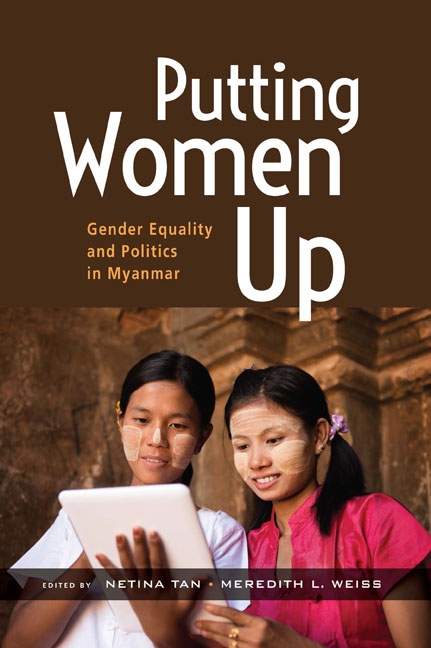Book contents
- Frontmatter
- Contents
- List of Tables
- List of Figures
- Acronyms and Glossary
- Acknowledgements
- About the Contributors
- 1 Putting Women Up: Promoting Gender Equality in Myanmar Politics
- 2 The Secret Garden of Candidate Selection and Women’s Political Participation
- 3 Ethnic Parties, Representation, and Female Candidate Recruitment in Myanmar
- 4 Attitudes Towards Women and Political Leadership
- 5 Violence, Gender, and Politics
- 6 Navigating Local Politics and Gender
- Appendix One Background of Selected Political Parties and Vote Shares
- Appendix Two Survey Questions
- Appendix Three Focus Group Guide for Field Data Collection
- Appendix Four Interview Guide Used for Field Data Collection
- Appendix Five Samples of Elite Interview Questions
- Index
5 - Violence, Gender, and Politics
Published online by Cambridge University Press: 18 April 2024
- Frontmatter
- Contents
- List of Tables
- List of Figures
- Acronyms and Glossary
- Acknowledgements
- About the Contributors
- 1 Putting Women Up: Promoting Gender Equality in Myanmar Politics
- 2 The Secret Garden of Candidate Selection and Women’s Political Participation
- 3 Ethnic Parties, Representation, and Female Candidate Recruitment in Myanmar
- 4 Attitudes Towards Women and Political Leadership
- 5 Violence, Gender, and Politics
- 6 Navigating Local Politics and Gender
- Appendix One Background of Selected Political Parties and Vote Shares
- Appendix Two Survey Questions
- Appendix Three Focus Group Guide for Field Data Collection
- Appendix Four Interview Guide Used for Field Data Collection
- Appendix Five Samples of Elite Interview Questions
- Index
Summary
Violence is a constant factor influencing Myanmar politics. The return to repressive, military rule in 2021 demonstrates how relevant violence is—and probably always was—for understanding political participation in Myanmar. This chapter investigates the political and gendered roles that violence plays, and the interlinkages between violence taking place in the public and private spheres. Whether violence is carried out by the Tatmadaw (Myanmar military) during an armed conflict or by an intimate partner against another, it follows gendered patterns and contributes to a gendered culture of violence. The relevance of the feminist slogan “the personal is political” is striking in the many examples of how this culture of violence affects the formal political process in gendered ways. This chapter brings together findings from previous parts of the book to shed light on how party politics and political candidates are affected by and experience gendered public attitudes and how a persistent culture of violence—public manifestations of militarization as well as tolerance of domestic violence—shapes gendered politics, even in a period of relative liberalization.
The chapter will demonstrate why and how the culture of violence in general, and domestic violence in particular, is crucial in shedding light on the opportunities and hurdles for “putting women up” in precoup Myanmar. It draws on the findings about violence that emerged from the various data collection efforts of the project as well as on sources external to the project. In doing so, it recognizes that violence is complex and continuous. It operates along a continuum that stretches from armed conflict to legacies that remain in peacetime (Cockburn 2004). The chapter also shows how violence that takes psychological forms, such as harassment and intimidation, and that takes place in the private sphere, such as domestic abuse, also has political and gendered repercussions (Bjarnegård 2018). The more democratic and peaceful period that Myanmar experienced around the elections of 2015 is here seen and analysed in light of the fact that it was both preceded and succeeded by more violent and repressive forms of governance. For a while, the introduction of democratic elections in Myanmar seemed to constitute an important step towards the peaceful resolution of conflict in the violence-ridden country, but political actors nevertheless operated with political violence in fresh memory and the period was not itself free of political violence.
- Type
- Chapter
- Information
- Putting Women UpGender Equality and Politics in Myanmar, pp. 119 - 142Publisher: ISEAS–Yusof Ishak InstitutePrint publication year: 2024



